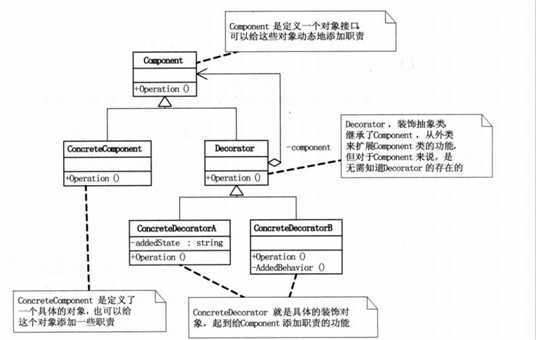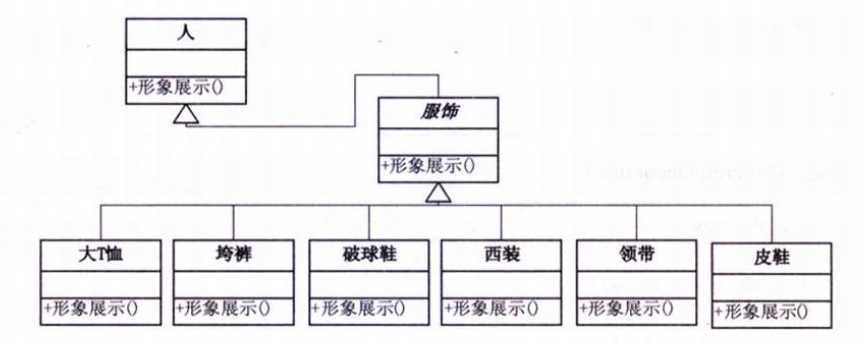标签:style class blog code http color
装饰模式(Decorator),动态地给一个对象添加一些额外的职责,就增加功能来说,装饰模式比生成子类更为灵活。
装饰模式结构图:

Component是定义一个对象接口,可以给这些对象动态地添加职责。ConcreteComponent是定义了一个具体的对象,也可以给这个对象添加一些职责。Decorator,装饰抽象类,继承了Component,从外类来扩展Component类的功能,但对于Component来说,是无需知道Decorator的存在的。至于ConcreteDecorator就是具体的装饰对象,起到给Component添加职责的功能。
Component类
class Component { public: virtual void Operation()=0; };
ConcreteComponent类
class ConcreteComponent:public Component { public: void Operation() { cout << "具体对象的操作" << endl; } };
Decorator类
class Decorator:public Component { protected: Component component; public: void SetComponet(Component component) { this.component=component; } //重写Operation(),实际执行的是Component的Operation() virtual void Operation() { if(component!=NULL) component.Operation(); } };
ConcreteDecorator类
class ConcreteDecoratorA:public Decorator { private: string addedState;//本类的独有功能,以区别ConcreteDecoratorB public: //首先运行原Component的Operation(),再执行本类的功能,如addedState,相当于对原Component进行了装饰 virtual void Operation() { Component.Operation(); addedState="New State"; cout << "具体装饰对象A的操作" << endl; } }; class ConcreteDecoratorB:public Decorator { private: void AddedBehavior(){}//本类独有的方法,以区别于ConcreteDecoratorA public: //首先运行原Component的Operation(),再执行本类的功能,如AddedBehavior(),相当于对原Component进行了装饰 virtual void Operation() { Component.Operation(); AddedBehavior(); cout << "具体装饰对象B的操作" << endl; } };
装饰模式就是利用SetComponent来对对象进行包装的。这样每个装饰对象的实现就和如何使用这个对象分离开了,每个装饰对象只关心自己的功能,不需要关心如何被添加到对象链当中。如果只有一个ConcreteComponent类而没有抽象的Component类,那么Decorator类可以是ConcreteComponent的一个子类。同样道理,如果只有一个ConcreteDecorator类,那么就没有必要建立一个单独的Decorator类,而可以把Decorator和ConcreteDecorator的责任合并成一个类。
下面举个例子——人的穿衣装扮
代码结构图

“Person”类(ConcreteComponent)
class Person { private: string name; public: Person(){}; Person(string name) { this->name=name; } ~Person(){}; virtual void show() { cout << "装扮的" << name << endl; } };
服饰类(Decorator)
class Finery:public Person { protected: Person *component; public: //打扮 void Decorate(Person *component) { this->component=component; } virtual void show() { if(component!=NULL) component->show(); } };
具体服饰类(ConcreteDecorator)
class Tshirts:public Finery { public: virtual void show() { cout << "大T恤" << " "; Person p; p.show(); } }; class BigTrouser:public Finery { public: virtual void show() { cout << "垮裤" << " "; Finery::show(); } }; class Sneakers:public Finery { public: virtual void show() { cout << "破球鞋" << " "; Finery::show(); } }; class Suit:public Finery { public: virtual void show() { cout << "西装" << " "; Finery::show(); } }; class Tie:public Finery { public: virtual void show() { cout << "领带" << " "; Finery::show(); } }; class LeatherShoes:public Finery { public: virtual void show() { cout << "皮鞋" << " "; Finery::show(); } };
主程序代码:
int main() { Person *awy=new Person("Awy"); cout << endl << "第一种装扮:" << endl; Sneakers *pqx=new Sneakers(); BigTrouser *kk=new BigTrouser(); Tshirts *dtx=new Tshirts(); pqx->Decorate(awy); kk->Decorate(pqx); dtx->Decorate(kk); dtx->show(); cout << endl << "第二种装扮:" << endl; LeatherShoes *px=new LeatherShoes(); Tie *ld=new Tie(); Suit *xz=new Suit(); px->Decorate(awy); ld->Decorate(px); xz->Decorate(ld); xz->show(); return 0; }
装饰模式是为了已有功能动态地添加更多功能的一种方式。但到底什么时候用它?起初的设计中,当系统需要新功能的时候,是向旧的类中添加新的代码。这些新加的代码通常装饰了原有类的核心职责或主要行为,但这种做法的问题在于,他们在主类中加入了新的字段,新的方法和新的逻辑,从而增加了主类的复杂度,而这些类新加入的东西仅仅是为了满足一些只在某种特定情况下才会执行的特殊行为的需要。而装饰模式却提供了一种很好的方案,它把每个要装饰的功能放在单独的类中,并让这个类包装它所要装饰的对象,因此,当需要执行特殊行为时,客户端代码就可以在运行时根据需要有选择的、按顺序地使用装饰功能包装对象了。
装饰模式的优点,是把类中的装饰功能从类中搬移去除,这样可以简化原有的类。而且有效地把类的核心职责和装饰功能区分开了,以及可以去除相关类中重复的装饰逻辑。不过要当心,装饰模式的装饰顺序很重要,比如加密数据和过滤词汇都可以是数据持久化前的装饰功能,但若先加密了数据再用过滤功能就会出问题了,最理想的情况,是保证装饰类之间彼此独立,这样他们可以以任意顺序进行组合了。
标签:style class blog code http color
原文地址:http://www.cnblogs.com/awy-blog/p/3805245.html